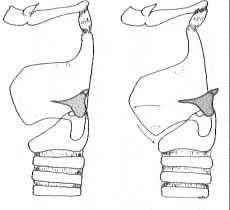
Do you think your voice is not particularly beautiful? Would you like to really move audiences with your authentic sound? Is it even possible to train your singing voice to be beautiful?
Reasons for unpleasant singing voice:
- There is lots of tension in the body and the throat (neck, jaw, tongue)
- The tongue is too far back
- The registration is faulty
- Too much breath pressure
- No body connection
- Bad pitch
- Lack of laryngeal tilt
To learn to get rid of all these problems and master your singing voice go through the link here: https://bit.ly/3huJNR8
What is a beautiful voice? Voices are highly individual and so are our tastes. We can safely say that any voice can be developed and become more beautiful if we know how to train and practice.
Who is to say what is beautiful, though? Just as beauty is in the eye of the beholder, so is the human sound in the ears of the listener. But we can offer some general viewpoints.
The main reason a voice sounds less than pretty (or should we say, plain ugly?) is that is has been buried deep under all kinds of tensions. In other words, the voice is not free.
In this article, we are going to go deeper into the mysteries of human sound and how to actually sing more beautifully. Check if any of them apply to you and become a better singer!
Tensions
It is sadly common that people have lots of tension in their bodies. All kinds of stress, both psychological and physical, affect us in numerous ways. Stress is known to wreak havoc on our health. The voice is very sensitive to stress, both in the actual laryngeal muscles that create the sound but also on all surrounding structures in the neck, throat, and body.
Become aware! Find your best posture and let all muscles that are not used for voicing relax. This doesn´t mean that you could just as well go to bed because we also need to carry our bodies in an active way. Just make sure your jaw hangs loosely, your neck is straight, your tummy muscles soft, your chest and throat open. Easy? No, no really. It takes surprisingly a lot of effort to be relaxed! What is natural is often not habitual.
Tongue Position
I have already written a post about the tongue. Check that out!
Registration
Lots of singers are confused about different vocal registers. You hear people talk about chest voice and head voice, falsetto, passaggio, breaks etc. An important point to remember is that registers are about vocal fold vibration. The vocal folds create our sound and they can vibrate with different thickness. This does not necessarily depend on the pitch – whether the sound is high or low.
The main rule and physiological fact is: the folds like to be thicker on lower notes and they must get thinner in order to sing higher notes. So, if you sing higher but don´t let the folds become thinner, basically you have to yell. Shouting always requires more pressure. So, if that sounds bad, your voice is no longer beautiful. It can be impressive, though. It can have a great impact. But it´s not necessarily what you call beautiful. Again, depending on your taste, of course. Heavy metal shrieks are probably not even meant to be pretty even though they are certainly amazing.
Breath Pressure
If you press your lips together and keep your mouth shut but still try to blow air, you will soon notice how pressure builds up in your body. Your abdominal muscles will work hard to push the air out. That is air pressure. Nature wants you to have pressure if you need to lift heavy objects. So, it is an absolutely normal thing in that situation. But this kind of pressure is not suitable for singing!
People think they need to support the sound with the body. Yes, absolutely. But pushing with the strong abdominal muscles is not the best way because it causes our vocal folds to close too tightly which we can hear as a pressed voice. And a pressed sound is not beautiful.
Body Connection
Okay, so if it´s not so great to support by adding air pressure, what should a singer do? This is a key question for many singing students. Support is really a balance between your inhaling muscles and your exhaling muscles. This means you have enough airflow to have your vocal folds vibrating but not so much pressure you push them apart.
It feels as if the voice has contact with the body; that you have enough air to sing and can relax the throat, jaw and tongue.
This balance can be learned and makes singing much more pleasing both for the singer and the listener.
Vibrato
Traditionally, a beautiful voice has an even vibrato. People generally hate wobbly voices, and some don´t care for straight tone, either. So, a nice vibrato sounds like the voice is free and flowing which, of course, is also beautiful.
How to control your vibrato then? In fact, all the points mentioned in this article about sounding great will also help with your vibrato: getting rid of tensions, learning to sing with the correct registration, finding your tongue position, balancing your breath pressure and developing your body connection are all fantastic basic tenets for a beautiful voice!
Laryngeal Tilt
There is one more issue that needs mentioning. That is laryngeal tilt. Many singers do it unconsciously because it is sort of built-in vocal technique. What is tilting? What happens when you tilt? What is actually being tilted? Can you feel it? Can you lose this ability?
Let´s try to answer some of these questions.
The larynx consists of three main cartilages: the thyroid, the cricoid and the arytenoids. The thyroid cartilage sits on top of the cricoid and they are connected to each other with a paired muscle, the cricothyroid. When the cricothyroid muscles contract they pull the thyroid a little forward and down thereby tilting the thyroid. While the arytenoids also rotate towards each other closing the glottic chink, the vocal folds close while stretching and lengthening at the same time. This tilting action can according to some research also happen the other way: the cricoid tilts toward the thyroid. Additionally, it has been found that people have different cricothyroid joints; so there can be different patterns of tilting.
However, this is very sciency information. Let´s just keep in mind that tiny little movements in the larynx affect the way our vocal folds vibrate when we sing. They don´t always happen when we speak. That is why some people find singing more difficult than others. So-called natural singers obviously do these things unconsciously.
In singing, we produce different pitches; the more the folds stretch, the higher the pitch. If there is no tilt we can still sing higher pitches but not as easily and the sound retains a speechlike quality. With thyroid tilt we can really SING!
Thyroid tilt is therefore very important. How can it be taught? Usually, it happens quite automatically and classical teachers ask for it from the very beginning when they show with their own voices and have students imitate head and mixed voice.
This terminology is confusing again – it is not produced in the head but by the vocal cords – but we FEEL it in the head. That´s why it has been named head voice long ago. It is the result of a function, not the cause of it. If we don´t have anyone to demonstrate tilted voice sound, we can also imagine crying or sobbing.
These are natural human responses and primal sounds that we can take advantage of when learning to sing. Crying means the tilt happens naturally; adding, even more, cry with sob also lowers the larynx. This enables us to vary the colors of the voice depending on the emotional contexts of songs.
If you have never been conscious of thyroid tilt it is possible to lose it. That can happen unfortunately for a number of causes. If too much pressure is used in singing the vocal fold vibration may become too thick and the lengthening/stretching of the cords gets more difficult. The fine edges of the cords that should be innervated and touch each other gently and firmly lose their sensitivity and thicken.
That calls for even more pressure which of course exacerbates the situation. We hear this kind of forced singing all the time.
The tilt that would enable the cords to stretch may be reduced. There are also cases where trauma to the neck or whiplash may cause deterioration of the laryngeal coordination, thus making singing very effortful.
How to tilt? Gently moan and cry, do the siren exercise (sing on –ng). You might palpate (= touch) the front of the neck gently and feel the tiny forward rocking motion. Tilting adds sweetness to the sound as well as healthy vibrato.
Tilt can be used in all genres, not only classical and it makes singing more comfortable and easier. Because this is such a crucial aspect of vocal technique and so much could be said about it, I will post another article about the subject. Coming soon!
Want to master your singing voice?
